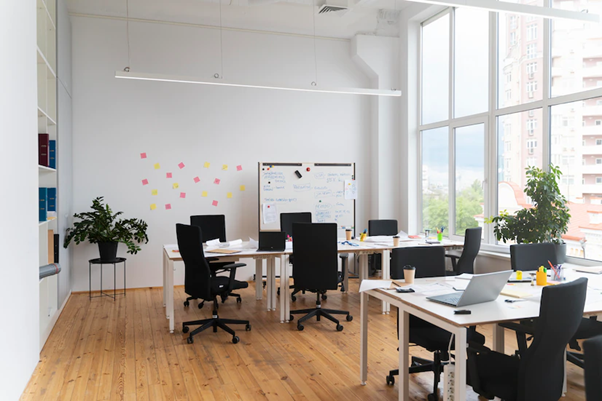Office design plays a very crucial role in today’s corporate work culture. Even if the job responsibilities are not that creative, employees would still enjoy working at the office and spending time while also ensuring productivity.
Imagine residing in a compact, cramped, dimly lit residence with uncomfortable furnishings and uninteresting interior decor. Chances are, you wouldn’t find pleasure in living there. Your enthusiasm, creativity, and productivity would likely diminish, prompting you to contemplate moving elsewhere. This is a reality that many job seekers confront when evaluating prospective employers.
Although the job may hold allure, the ambience often dissuades individuals. This is particularly true for Generation Z and millennials. To draw in and retain these well-educated younger professionals, it is imperative to revamp your office space.
Below are some straightforward points outlining the steps you can take to attract and retain such valuable talent while choosing and designing your next workplace.
Factors to Consider Before Designing the Workspace
Choosing a particular office design like biophilic, ergonomic and many more depends on factors like the size of the firm, nature of work, etc. You need to hire a professional Office Interior Designer to ensure that your office design matches the expectations of employees.
Below are some of the factors that you should consider before designing your workspace:
Choose the best office design based on the nature of the work
An individualised assessment is necessary when considering workplace interior design. Certain design aspects, like creating an inviting break room or lunch area to promote employee relaxation and collaboration, are likely to be universally favoured across all industries. However, each business is likely to adopt a unique design and arrangement for these spaces.
For instance, a media or advertising company with a lively and playful culture might opt for bean bags in their relaxation areas, while a bank is less likely to embrace such a choice. A successful workplace should mirror your company’s culture, offering potential employees a glimpse into the working environment and aiding in the retention of top talent over an extended period.
Emphasize employee well-being
Remote workspace poses a significant challenge in today’s fiercely competitive job market. With the allure of increased flexibility, the ability to step outdoors, engage in physical activities, and take breaks as needed, a growing number of individuals have come to value the convenience of remote work and are reluctant to relinquish it even after two years.
Leading employers catering to job seekers have recognized that offering amenities like a juice bar or an in-office gym has become the norm. Our concept of well-being is evolving to encompass a wider range of amenities focused on both mental and physical health, creating overall healthier work environments.
Promoting more active work routines during the day involves innovative strategies, such as making staircases a prominent feature in office design. Given that each person’s perception of well-being is unique, organisations are tasked with finding inventive ways to foster the physical and mental health of both current and prospective employees, necessitating a rethinking of workplace design.
Encourage activity-based work
To attract the best talent in the future and foster productive collaboration, it’s crucial to understand their motivations. Activity-based working acknowledges that individuals engage in a range of tasks as part of their daily work routine.
Consider spaces for brainstorming, team meetings, dining areas, communal workspaces, virtual meeting rooms, and coffee shops thoughtfully designed by architects and hospitality experts. The emerging workforce expects and desires an innovative physical work environment that encourages diverse communication styles.
Reduce distractions while work
Reduced distractions stand out as a primary rationale cited by individuals who find working from home appealing. To mitigate distractions, one strategy within contemporary office design is to integrate acoustic furniture. These pieces can be seamlessly integrated into communal spaces, creating a private and tranquil atmosphere while preserving an open feel.
A thoughtfully designed workspace can lead to elevated employee engagement and heightened productivity. An up-to-date office layout has the potential to cultivate a stronger sense of affiliation with your organisation. These connections foster engagement and contribute to reduced turnover rates.
Sustaining the existing workforce has emerged as a significant challenge for businesses in response to the increasing demand for skilled labour.
Keep the employees satisfied
Numerous studies have investigated the importance of employee well-being in the workplace and have consistently found that cultivating the right organisational culture plays a central role.
Nevertheless, there are straightforward adjustments you can make to your office design that can aid employees in relaxing, motivating them, and sustaining their contentment during the workday:
- Colour: Incorporate soothing and neutral colour schemes when arranging your workspace to create a sense of comfort among your team. Colours like blue and green are commonly chosen for office decor, as they are believed to have a calming influence that can boost productivity.
- Furniture: Consider the addition of soft and comfortable furnishings as well. Creating an atmosphere that feels ‘homely’ will make your employees feel cared for and motivated.
- Elements: Research has extensively explored the benefits of incorporating plants into the workplace. Plants contribute to vitality, well-being, and aesthetic appeal.
- Lighting: When designing your office layout, it’s advisable to ensure that no furniture obstructs access to natural light from windows. Natural light has a calming impact on mood and can enhance employee focus and productivity throughout the day.
Conclusion
In a highly competitive landscape where organisations vie for the most exceptional talent, businesses must employ every available means to attract and retain top-notch employees.
One effective strategy to achieve this is by leveraging your workplace environment, creating spaces that are not only desirable but also conducive to fostering growth and success, which can play a pivotal role in appealing to and retaining top talent in your industry.


